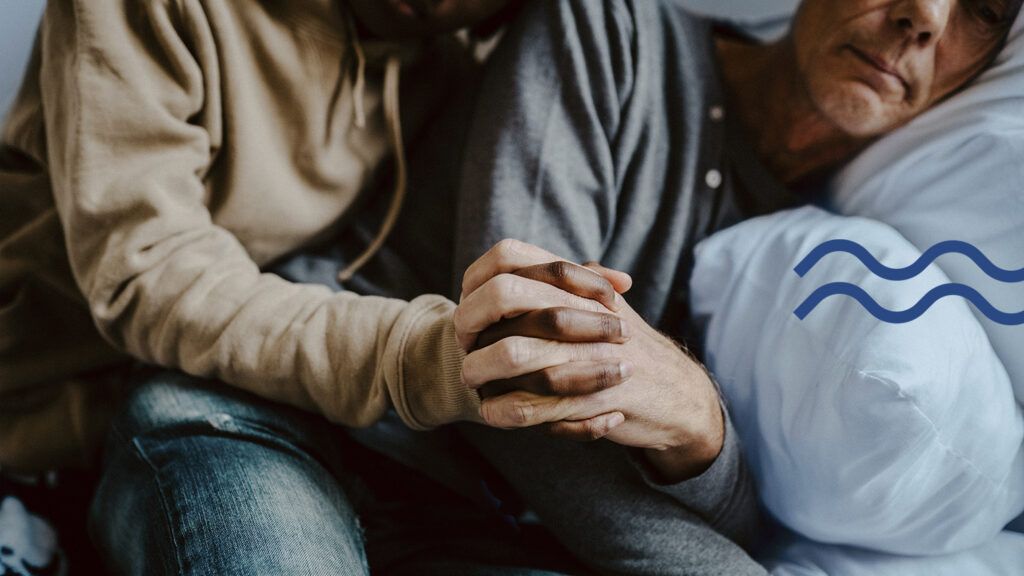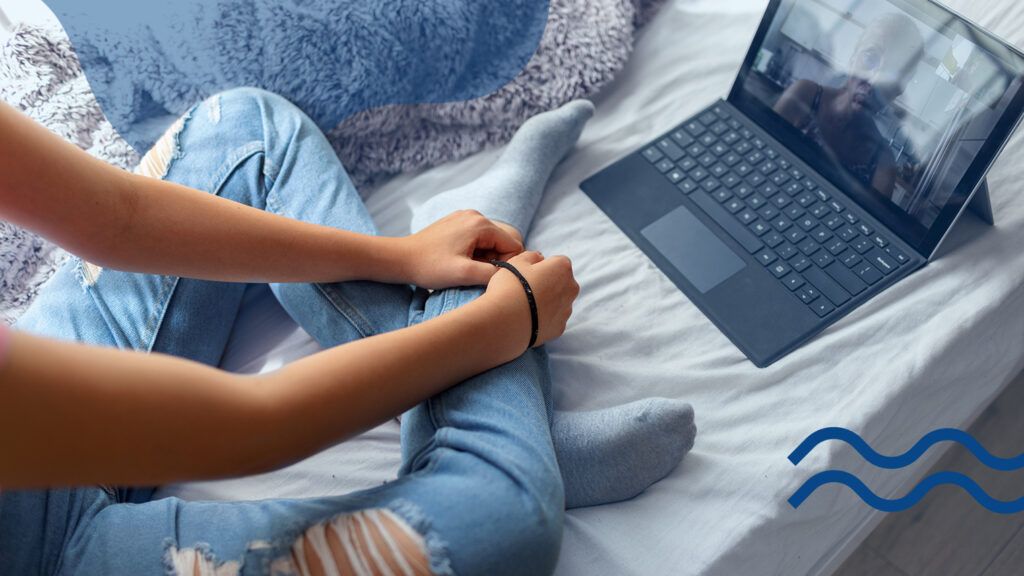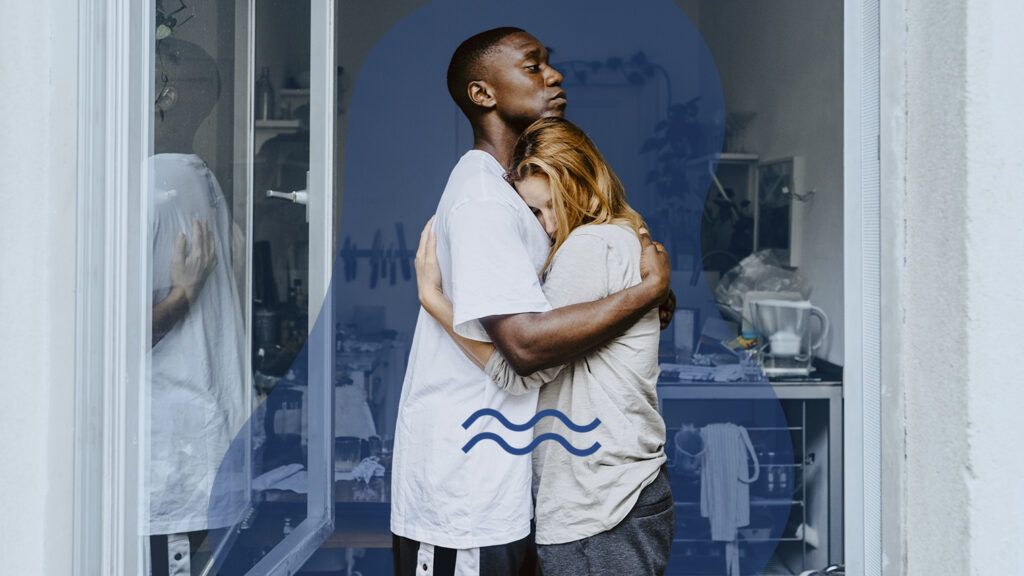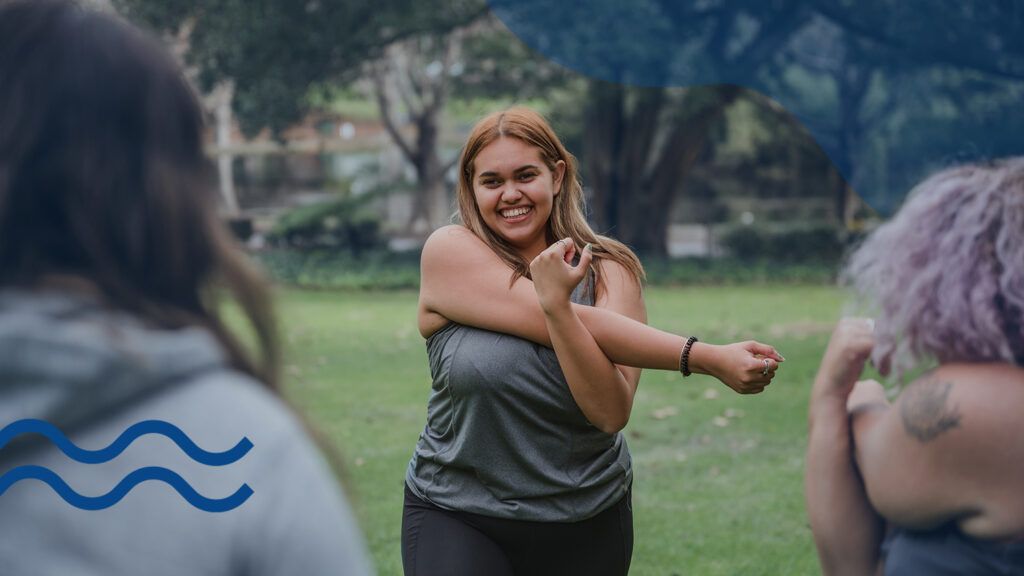What an Increased Awareness of Depression Means for Those Who Have Lived With It for Years
July 01, 2022
Content created for the Bezzy community and sponsored by our partners. Learn More

Design by Yunuen Bonaparte; Photography by urbazon/Getty Images
The increased openness in talking about depression has mostly been positive — but is there a downside?
When Ashley Tully was in one of her deepest bouts of depression, she found it helpful to listen to others share their own stories of depression: why they got depressed, what their lowest point looked like, if and how they got better, and who was particularly supportive during the process.
“I think [that] common experience, it helps you feel less alone,” says Tully, an agriculture specialist and educator living in Livingston Manor, New York. She listened to these stories mostly on podcasts, which were easy to access but offered distance.
“Because it’s safe, right?” she explains. “In some ways, you’re still not ready to open up, but you can take in this information without being vulnerable or exposing yourself or risking your safety.”
The fact that these podcasts even exist to potentially make people feel less alone — Terrible, Thanks for Asking and Mental among them — is part of a greater awareness of depression and mental health that’s taken place in the last couple of years.
At the same time, this push for self-care and openness coincides with a reported decline in people’s mental health that began before the pandemic, and has certainly only continued to get worse since.
Depression, self-harm, and suicide is rising among American adolescents, in particular among LGBTQIA+ youth; and among adults, the national rate of suicidal ideation has increased every year since 2011.
So, if these issues are in the spotlight now more than ever, why is the state of people’s mental health worsening? And what does it mean for people who have been living with depression all along?

Design by Yunuen Bonaparte; Photography by Rebecca Smith/Getty Images
Why are depression rates so high right now?
Having removed a lot of the protective factors that were keeping people afloat pre-pandemic (being in community, in-person services, and more), it’s easy to understand why mental health has worsened as a result of the pandemic. But it’s hard to say whether mental health was also worsening prior or people are just willing to be more open about it now.
“Has depression increased? I don’t know,” says Laryssa M. Creswell, a licensed clinical professional counselor based in Edgewater, Maryland. “I think that, because the light has been shined on it, we’re seeing it more and we’re just more aware of it.”
She likens it to police violence against Black people. “Has there been an increase in the way in which police officers have treated Black people? Not necessarily. It’s just that it’s been recorded,” she says.
Karina Solis, a licensed mental health counselor at Thriveworks in Somerville, Massachusetts, agrees. “I think it’s always been there,” she says. “It’s just now coming out to the open.”
I wish there was more discussion on failures … We always talk about the success and the thing that made you a millionaire. And I think that sets a bar that’s unrealistic and very unhelpful for one’s mental health.
— Rachael Lee Hyatt, LCSW
Where does this high rate of depression stem from?
As to why we’re seeing such a high rate of depression right now, Rachael Lee Hyatt, a licensed clinical social worker based in Brooklyn, New York, points a figure to social media, for one.
She now sees Instagram as a curated platform largely used by professional influencers. But before that, it was more everyday people sharing their lives, and there was a lot of, “Let me show you what I’m doing, and how glorious and fantastic and perfect it is,” she says. “And I think that created this space of massive comparison and massive pressure to be better, to have this really fabulous and glamorous life that everyone was posting about.”
Hyatt started to observe her clients, who range in age from their 20s to their 40s, becoming increasingly self-conscious, caring more about what other people thought, and feeling like their lives weren’t as “fabulous” as they should be.
“That’s a really easy space to start feeling very depressed and feeling like, ‘I’m not good enough,’ ‘I can’t do this’ or, ‘My life doesn’t look like this, so I must not be enough,’” she says.
Creswell agrees that social media is a factor, but believes that it doesn’t stop there. She sees advances in technology across the board as having exacerbated the problem.
“What they have on their plates just didn’t exist … 30 years ago,” she says speaking about adolescents, in particular, a population she specializes in. She’s talking about having 24/7 access to information, whether via social media, smartphones, TV, or the news.
Creswell brings up bullying as an example of how constant access has altered the landscape for the worse. “[In the past], if you were being bullied at school,” she says, “it stopped once you left because they only had access to you while you were at school …[But now], it doesn’t stop. It’s a constant — they can continue to come for you all day, all night if they want to.”
She adds, “What teenagers are challenged with now is way different than what it was before. And so, while we are seemingly more connected, we are less connected in a sense.”

Another factor Hyatt thinks plays a role in fueling depression is societal pressure to be perfect.
“It can fuel really severe depression. If we feel like we have to be perfect, then nothing that we do is ever perfect [enough], and then we get very depressed,” she says. “And then with severe depression, you don’t do anything because it’s not going to be perfect.”
On a related note, she also thinks there’s a collective pressure right now to focus on end results rather than process, which helps contribute to the problem. She sees this as stemming all the way back to grade school — for example, the idea that “I don’t care how hard you studied for the test or how much you learned, I only care if you got an A.”
“I wish there was more discussion on failures. Failing is not a bad thing. I wish we could celebrate it a little bit more,” she says. “But we always talk about the success and the thing that made you a millionaire. And I think that sets a bar that’s unrealistic and very unhelpful for one’s mental health.”
You have so many celebrities talking about postpartum depression, experiences with depression during grief … There’s so much more room to just take up space and say, ‘My mental health is not great.’
— Imadé Nibokun
The shift: The pros of the increased awareness about depression
Almost everyone I spoke with agreed that, yes, they’ve definitely noticed more of an openness in talking about depression and a willingness to seek out therapy — and that, for the most part, it’s a good thing.
Creswell and Hyatt have both observed their clients being more casually open about therapy and depression with friends and even strangers.
“I have some teens, they’re like, ‘Yeah … I was talking to my therapist,’ and it’s like they’re just going out for coffee or something,” Creswell says, “whereas at least during my time, to say that you’re going to see a therapist was like, ‘Oh, you must be crazy.’”
Knowing that’s how people would respond was a major deterrent to saying anything, so people would often keep it to themselves, Creswell explains. “But the teens of today, they’re like, ‘I have a therapist, and you should get a therapist, too!’”
She thinks there’s still work to be done, but she says recent progress has been effective in getting people to be more open, which can only be good.
“That leads to us talking about it, right? Because otherwise, we’re working in silos,” she says. “I think the thing is to keep the atmosphere of that sense of safety where it is OK for me to be able to talk about it.”
Hyatt sees this increased openness almost as a permission slip for others to share their own stories and seek help themselves.
“If you feel like you’re the only one, it’s just gonna [drive] you further into feeling depressed. And so if it feels a little bit more normalized, like, I’m not the only one and there are other people that deal with it,” Hyatt says, “I think that’s really positive for individuals, and for our community as a whole.”
Solis has seen this play out in her own practice. “There are so many clients who will say, ‘I’ve always thought about this, but I never wanted to go to therapy because I didn’t want people to think that there was an issue with me,’” she says.
Now that they’ve seen the stigma dissipate, “people can seek the help that they need.”
She wishes this shift would have taken place 20 or 30 years ago, but she’s glad it’s happening at all. “For everything, we have to start somewhere,” she says.

Imadé Nibokun runs the nonprofit Depressed While Black (which donates Black-affirming personal care items to psychiatric patients), and she lives with major depressive disorder and borderline personality disorder. Nibokun thinks the fact that everyone is talking about it makes it “the easiest time to say that you deal with depression or anxiety as a Black person.”
Nibokun adds, “You have so many celebrities talking about postpartum depression, experiences with depression during grief … There’s so much more room to just take up space and say, ‘My mental health is not great.’”
Is there a downside to this increase in awareness around depression?
That being said, Nibokun feels the narrative that’s being shared most prominently is a bit too one-note. It’s very much like, “I had depression for a short period of time — and now it’s over,” she says. “So, we do need more depictions of chronic mental illness, not just the ‘I overcame’ stories.”
Many people don’t “overcome” depression. Major depressive disorder affects more than 16 million adults in the United States in a given year, Nibokun included.
She does point to one exception, though, that she’s noticed: the show “Crazy Ex-Girlfriend.” Nibokun feels that, when it comes to telling stories about mental illness and depression, in addition to the “I overcame” narratives, it’s the “cute stories” that usually get centered, as opposed to the messier, more complicated stories.
“In ‘Crazy Ex-Girlfriend,’ she is difficult and she’s challenging to deal with,” she says, “and I thought it was such a game-changer, and it really humanized folks and normalized people who have severe mental health conditions outside of depression and anxiety.”
However, yet again, there’s social media. While Hyatt thinks it’s helpful to have social accounts where people talk about mental health — these accounts increase awareness and help people identify unprocessed emotions — she worries that some people may take what they read on these accounts as gospel, which could be problematic.
“Treating mental health is very much an individualized thing. We all suffer for very, very different reasons,” she says. “And so I think, if we try to say, ‘I can just read this stuff online,’ or, ‘I follow this one person on TikTok or Instagram and that’s my therapy,’ I think that’s the only space for it to not be helpful.”
Tully, who also agrees that the increased attention is positive overall, and has clearly benefited from it herself, admits that she can imagine people who are severely depressed feeling like the conversation isn’t about them.
“There’s always this learning curve of change,” she says, so that that may be true, “but that doesn’t mean this isn’t still the path towards progress, which is openness.”
The hope is that this is just the beginning.
“I want the conversation to be bigger … We can’t decide to only help one portion of society who needs help … and then call it a success.”
— Nicolette Lafonseca
Who is included — and who is not?
Tully is onto something, though, in thinking that everyone may not feel included in the conversation. Nibokun, for instance, does not feel included. She feels like the “anti-mental health stigma movement” focuses only on people with mild mental health conditions, often the same people with the “I overcame” stories.
“It assumes that you’re mentally well enough to call 50 therapists to see if they’re taking new clients,” she says.
If you’re at an extremely low point, you might not be able to get out of bed, let alone try to seek help at a time when help is notoriously difficult to find.
Nicolette Lafonseca, who owns the sustainable concept shop Le Weekend and lives in Cornhole, Yorkshire, sees it this way, too.
“If we’re always shown success stories or stories of mental health where it …has a happy ending, then people who haven’t got a light at the end of the tunnel are going to feel like a failure,” says Lafonseca, who has been diagnosed with bipolar disorder with psychosis and schizophrenia.
She has spoken to others with long-term mental illnesses like herself who also feel like there’s no place for them in the conversation because the stories they have to share seem too dark and too scary for many.
“I think that mental health has become sanitized into something that we can manage, that marketing can get behind, that they can [use to] promote their mindfulness app or their scented candle,” she says. “I have psychosis. I’m not going to be fixed with a scented candle.”
Lafonseca explains this does not negate the suffering of anyone living with less severe conditions.
“We’re not grading on a curve. Your grief is your grief,” she says. “And it’s huge, and it’s yours, and you own it …We’re not playing ‘mine’s bigger than yours,’ because that doesn’t get anyone anywhere.”

She does, however, feel that people should do a better job of being inclusive. No matter if they’re talking about someone living with chronic depression or someone who experiences postnatal depression, which often comes with an end date, there shouldn’t be a hierarchy of which matters more.
“They’re all important,” Lafonseca says, “but there needs to be a place for everybody at the table.”
She adds, “I want the conversation to be bigger … We can’t decide to only help one portion of society who needs help … and then call it a success.”
How easy is it to find help these days?
It would be an understatement to say that the pandemic shifted people’s lives in many fundamental ways, and therapy is no exception. Nibokun, who found her current therapist, whom she loves, on Psychology Today, points out that the pandemic allowed her to open up her therapist search to the entire state. As someone looking for a Black therapist qualified to treat her specific diagnoses, this was huge for her.
“Having somebody who I can speak to virtually, beyond the limited number of therapists in my city,” she says, “it’s just a game-changer. And I hope that more people with severe mental health conditions take advantage of that.”
Online therapy, Hyatt adds, has also been incredibly helpful for people who don’t have the time to travel (maybe because of work or kids), or who live in more rural places and don’t have many therapists nearby. But, she says, the openness we’ve been talking about, plus the anxiety the pandemic has added, has naturally led to a “big increase of people saying, ‘Actually, I do want to talk about mental health.’”
This is great, but it has led to a shortage of sorts.
“I think it’s really good that … it’s more accessible. You can do it from your home, you can get [therapy] on your lunch break. But at the same time, there’s more demand,” she says. “It’s been really hard to even have space to accept new clients.”
Plus, Hyatt points to the elephant in the room: the financial piece of it. The unfortunate reality is that “it’s just too expensive for a lot of people to be able to prioritize it,” she says.
Creswell, who spent the majority of her career working in community mental health and at a psychiatric hospital, seconds this. “The population is just totally different in terms of being able to access the treatment,” she says.
She talks about lower-income families, who are more likely to have to depend on community mental health, “which is totally fine,” she says, “there are great clinicians working in that field,” but that’s not the only factor.
“You also run up against availability — do they have enough therapists in that particular facility? And then, can the clients make it there, or do they have to find transportation to get there?” she explains.
There are all these other barriers that can come into play. But with the population she currently sees in her private practice, “their ability financially to access the treatment is greater.”
The increase in demand has also led to the market being flooded with traditional therapy alternatives, which some say can’t possibly do what they claim, and others say they’re left out of entirely.
Before Nibokun found her current therapist, she tried one of the therapy apps. “The moment I said I deal with chronic suicidal ideation,” she says, “they were like, ‘Here’s your suicide prevention number.’” So Nibokun dropped her.
This brings us back to the people this increased awareness — and the increased services that have come out of it — includes and helps.
Solution ideas and hopes for the future
Nibokun is hopeful that this increased public awareness and acceptance of mental health issues will start to expand to her and others who deal with similar serious conditions. She feels like those with larger platforms can help move the needle forward.
“The more that celebrities disclose their schizophrenia, their bipolar, their mental health conditions … outside of [just] depression and anxiety,” she says, “I do think it will be a cultural shift.”
She also wishes for an expansion of peer respite centers, supportive environments where people can go to wait out their mental health crises, “where they have the ability to have agency and self-determination.”
Nibokun sees this as an improvement from being placed in facilities you can’t leave, which can be a real disruption to everyday life.
An increase in mental health first responders, too, when it comes to crises involving mental health conditions, addiction, and more, is key (essentially what the defund the police movement largely focuses on). This has been happening across the country in places like Denver and Oakland.

Bobbi Lockyer/Refinery29 Australia – We Are Many Image Gallery/Getty Images
Nibokun points to the Cahoots program as a successful model in Oregon. We should “treat mental illness the way we treat heart attacks,” she says. “We don’t send the police when somebody has a heart attack. We send EMTs.”
Everyone I spoke with agreed that better funding and improved healthcare would be instrumental in creating a world in which patients didn’t have to choose a mere two sessions a month based on their budget, and therapists could take on any client, no matter their insurance reimbursement, while also being guaranteed a fair wage themselves.
“Those who are in the lower-income community should be able to receive the same type of treatment, as those who have million-dollar-and-above incomes,” Creswell says. “It should be the same across the board.”
And for the million-dollar question: How do we get there? Creswell suggests lobbying your congresspeople, and saying what you need, what you want, and what your community needs — and then holding them accountable. She talks about the importance of voting, not just every four years in presidential elections, but also in smaller elections in your community.
“It’s building, and getting the people in who you want,” she says, adding that reaching out to professional organizations such as the American Counseling Association and the American Psychiatric Association, and telling them what you need helps, too.
“They listen, they look for that,” she says, emphasizing the sheer importance of numbers. “The more people that are doing it and saying it, the greater likelihood [you have of] seeing what you want done.”
Creswell is also a firm believer of giving a voice to the voiceless, particularly when it comes to people of color and the LGBTQIA+ community, with whom she works closely. “The more that you can … find them and talk to them and print what they have to say, that’s huge,” she says.
Takeaway
Some who have lived with depression for a long time may be wondering why this is all so important now when it’s something that has been a priority to them for so many years.
Creswell’s response to that is: “Why not now?”
She continues, “At least in my years, that’s been the point.” She’s referring to all the calls she’s made to Congress members, the times she’s gone to Capitol Hill to advocate for patients, and all the things she and so many others like her have done to boost awareness about depression and mental health over the years.
“It finally caught fire,” she says, “so, now that it’s here, let’s embrace it, and let’s do all that we can, while we can.”
Medically reviewed on July 01, 2022
12 Sources


Like the story? React, bookmark, or share below:
Have thoughts or suggestions about this article? Email us at article-feedback@bezzy.com.
About the author